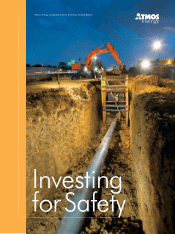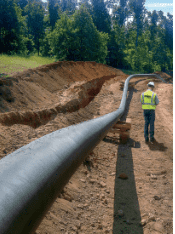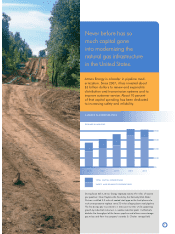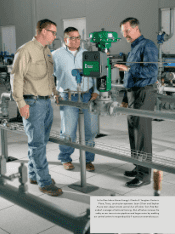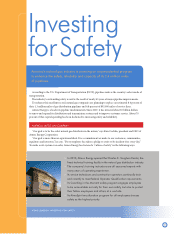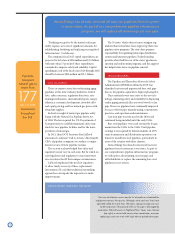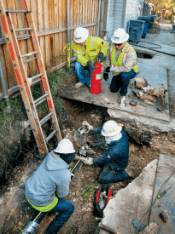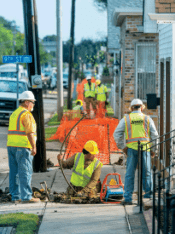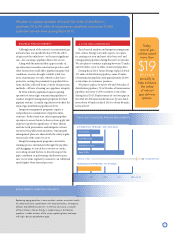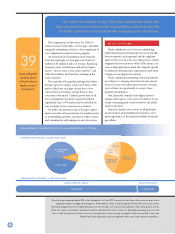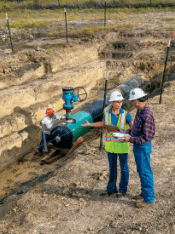Atmos Energy 2014 Annual Report Download - page 9
Download and view the complete annual report
Please find page 9 of the 2014 Atmos Energy annual report below. You can navigate through the pages in the report by either clicking on the pages listed below, or by using the keyword search tool below to find specific information within the annual report.
7
Today,
natural gas
utilities spend
more than
$19
BILLION
annually to
help enhance
the safety
of natural
gas delivery
systems.
We plan to replace between 450 and 500 miles of distribution
pipelines,
70 to 90 miles of transmission pipelines and some 25,000
customer service lines during fiscal 2015.
ATMOS ENERGY: INVESTING FOR SAFETY
Replacing aging pipelines in communities involves a constant watch
for safety and close coordination with local authorities, emergency
officials and affected customers. In Gretna, Louisiana, a suburb
of New Orleans, Atmos Energy is modernizing its distribution
pipelines in older sections of the city by replacing bare steel pipe
with high-density polyethylene pipe.
FISCAL 2015 PROJECTED PIPELINE REPLACEMENTS
ENSURING PIPELINE INTEGRITY
Although much of the nation’s current natural gas
infrastructure was installed before 1970, the eect
of age is not the only factor—or the most signicant
one—for assessing a pipeline’s tness for service.
Along with the material that a pipe is made of,
operators must consider construction practices and
other factors that could aect pipeline integrity. Soil
conditions, erosion, drought, rainfall, wind, tree
roots, maintenance records, whether a line has a
protective coating, the proximity to populated loca-
tions and data collected from a variety of inspection
methods—all have a bearing on a pipeline’s integrity.
In 2004, federal regulations began requiring
operators of natural gas transmission pipelines to
conduct integrity management programs for their
pipeline systems. A similar regulation took eect for
natural gas distribution pipelines in 2011.
Integrity management programs require a
comprehensive examination of pipeline infra-
structure. Federal and state rules require pipeline
operators to assess threats to their system, apply risk
analysis to grade the signicance of those threats
and take both preventative and mitigative actions
to protect the public from incidents. Our integrity
management plans are shared with the safety regula-
tors in each of the states we serve.
Integrity management programs can involve
running precise instruments through the pipeline,
called pigging, to search for corrosion or cracks,
excavating around the line to directly inspect the
pipe’s condition or performing a hydrostatic pres-
sure test of a line segment to ensure it can withstand
much higher-than-normal pressure.
A LONG-TERM UNDERTAKING
Based on risk analysis and integrity management
data, Atmos Energy currently expects to replace
its existing cast iron and most of its bare steel and
vintage plastic pipelines during the next two decades.
We also plan to continue replacing between 75 miles
and 100 miles a year of older coated steel pipelines.
During scal 2014, Atmos Energy replaced about
375 miles of distribution pipelines, some 95 miles
of transmission pipelines and approximately 23,000
service lines to customers’ premises.
We plan to replace between 450 and 500 miles of
distribution pipelines, 70 to 90 miles of transmission
pipelines and some 25,000 customer service lines
during scal 2015. Replacements of cast iron pipe in
the Mid-Tex Division should increase by one-third,
from about 60 miles in scal 2014 to about 80 miles
in scal 2015.
DISTRIBUTION PIPELINES: 450– 500 MILES
CAST IRON
COATED STEEL
VINTAGE PLASTIC
BARE STEEL
SERVICE LINES
TRANSMISSION PIPELINES: 70–90 MILES
25,000 SERVICES
0 50 100 150 200 MILES

